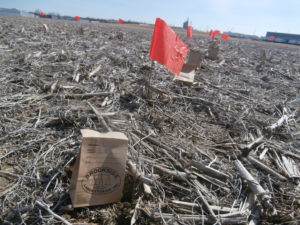Soil Testing: Why It Matters
September 6, 2018 Ohio Soybean Council
By: Kayla Weaver
With farmers in Ohio under increased scrutiny for nutrient run-off, soil tests can help growers make decisions about which nutrients should be applied for a viable crop in the upcoming season. Soil testing also gives farmers another layer of data that lends itself to improving production practices and overall farm management. While there are several methods to test soil, the end goal is the same — to obtain high quality data that offers an accurate look at soil health and available nutrient levels.
With most farms being on a two-crop rotation, Luke Baker, president and CEO of Brookside Laboratories, Inc. in New Bremen, Ohio, recommends soil testing every other year. No matter the years in between, Baker notes that consistency is key. Samples should be pulled in the same month every time. There is chemistry happening in the soil that can make samples from different seasons hard to compare.
Grid sampling and zone sampling are the two most popular sampling options. Grid is a good place to start if the field data is a blank slate. However, to get the best accuracy, it needs to be done in quarter-to-half acre grids with costs adding up quickly. The other method is selecting zones based on factors such as soil type, elevation or soil drainage, yield data collected in prior years and other characteristics. While zones may not cover every area of the field equally, they provide more flexibility to add or split zones according to known data and can be a more affordable option.
Baker prefers the zone method. “There is a lot of debate out there, but we use the zones because they can morph and adjust as you’re constantly layering and compiling data on top of it. It’s not perfect, nothing is, but we like them better than grids because you’re not locked into a square — mother nature doesn’t work in perfect squares.”

Each defined area should have 10-15 probes at a 0 – 6-inch depth depending on farming practices. The tri-state fertilizer recommendations are currently based on six-inch samples; however, revised recommendations are in the works and they may address depth as well. “You need to be consistent with your depth, especially because you’re trying to trend over time. Stay consistent with date, depth and zones if you want to go back and compare across time. Bad samples in means bad data out — you have to be careful,” said Baker.
Phosphorous is currently the biggest factor in the water quality discussion, but other nutrients are becoming a concern. Sulfur is starting to make a resurgence after it declined since the Clean Air Act of 1990. Manganese deficiency is also a concern for low-lying areas, but it depends a lot on weather conditions.
A high-yielding crop year can make a difference for micro-nutrients as well, leading to a need for foliar feed during
the growing season.
“Something we stress with fertilizer applications, especially with phosphorous, is getting it tilled into the soil — deep
band it or use some vertical tillage to get it mixed in. Phosphorous needs to come in contact with the soil, once it makes contact it doesn’t move much unless there is a huge run-off event. Potassium and nitrogen will leach into the soil with rain, but phosphorous is different,” said Baker.
In addition to soil testing, tissue testing has become more popular to get a baseline of nutrient uptake at different growth stages and detect deficiencies early when there may be a chance for a rescue treatment. It also helps evaluate application rates and adjust for your specific soil and field conditions.
“Tissue testing shows how the plant is performing relative to the nutrient levels you have in the soil. It will help prove some of the things you do with your soil test.”
While soil testing can be an up-front investment, the data and knowledge collected can prove invaluable over time by saving farmers time and money while maximizing yield potential.
Article Tags: Magazine | Ohio Soybean Council News | Ohio Soybean News | Soil Sampling | Water Quality
